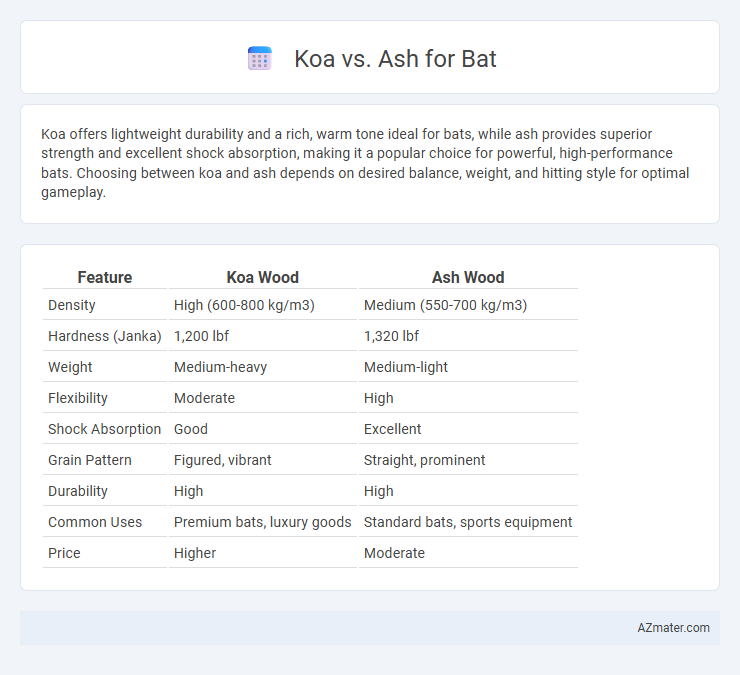Koa offers lightweight durability and a rich, warm tone ideal for bats, while ash provides superior strength and excellent shock absorption, making it a popular choice for powerful, high-performance bats. Choosing between koa and ash depends on desired balance, weight, and hitting style for optimal gameplay.
Table of Comparison
| Feature | Koa Wood | Ash Wood |
|---|---|---|
| Density | High (600-800 kg/m3) | Medium (550-700 kg/m3) |
| Hardness (Janka) | 1,200 lbf | 1,320 lbf |
| Weight | Medium-heavy | Medium-light |
| Flexibility | Moderate | High |
| Shock Absorption | Good | Excellent |
| Grain Pattern | Figured, vibrant | Straight, prominent |
| Durability | High | High |
| Common Uses | Premium bats, luxury goods | Standard bats, sports equipment |
| Price | Higher | Moderate |
Introduction to Koa and Ash Woods
Koa and Ash woods are renowned for their unique physical properties and aesthetic qualities in bat manufacturing. Koa wood, native to Hawaii, is valued for its rich grain patterns and medium density, offering both durability and a striking visual appeal, ideal for high-performance bats. Ash wood, widely used across North America, provides a lightweight structure with excellent shock absorption, making it a preferred choice for players seeking a balanced combination of strength and flexibility.
Botanical Origins and Growth Environments
Koa (Acacia koa) thrives predominantly in the volcanic soils of Hawaii's mesic and wet forests, exhibiting a preference for elevations between 100 and 2,200 meters. Ash (Fraxinus spp.) generally grows in temperate regions across North America, Europe, and Asia, favoring well-drained, fertile soils in mixed woodlands. The distinct botanical origins and native growth environments of Koa and Ash influence their wood properties and ecological adaptability essential for crafting premium bat materials.
Physical Appearance and Grain Patterns
Koa wood exhibits a rich, reddish-brown hue with golden highlights and complex, chatoyant grain patterns that create a striking visual depth, making it highly prized for high-end bat manufacturing. Ash bats feature a lighter, creamy white to pale yellow color with straight, pronounced grain lines that provide a classic, traditional look and exceptional strength. The contrast between Koa's dramatic figuring and Ash's uniform grain appeals to different player preferences seeking either aesthetic uniqueness or reliable performance.
Weight and Balance Attributes
Koa wood, prized for its density and strength, offers excellent weight and balance attributes crucial for crafting high-performance bats, delivering a solid feel with optimal swing control. Ash, known for its lighter weight and exceptional flex, provides superior balance, enabling faster bat speed and better control during swings. Both woods influence bat performance distinctly; Koa ensures durability and power, while Ash emphasizes agility and precision in bat handling.
Durability and Strength Comparison
Koa wood offers superior durability and strength compared to Ash, making it ideal for heavy-use applications like musical instruments and furniture. Koa's dense grain structure provides excellent resistance to wear and impact, surpassing Ash's moderate hardness and flexibility. While Ash is known for its shock absorption, Koa's combination of toughness and longevity ensures longer-lasting performance under stress.
Performance Impact in Baseball
Koa and Ash bats significantly differ in performance impact due to their distinct wood densities and flexibilities; Koa bats offer a harder, denser grain which results in higher ball exit speeds and longer durability, enhancing power hitting in baseball. Ash bats, known for their lighter weight and greater flexibility, provide superior swing speed and control, benefiting contact hitters who rely on precision rather than raw power. The choice between Koa and Ash ultimately affects bat speed, swing mechanics, and the overall energy transfer to the baseball, influencing hitting performance metrics such as distance and power.
Popularity Among Professional Players
Koa is more popular among professional players for its lightweight design and flexible middleware system, which offers superior performance in building RESTful APIs. Ash, while gaining traction for its simplicity and type safety using TypeScript, currently holds a smaller share of the professional community compared to Koa. Metrics from GitHub stars, npm downloads, and usage in enterprise projects indicate Koa's dominance in production-ready Node.js frameworks favored by seasoned developers.
Sustainability and Environmental Factors
Koa wood exhibits exceptional sustainability due to its rapid growth in Hawaii's reforested areas and natural resistance to pests, reducing the need for chemical treatments. Ash wood, while durable and widely available in North America, faces challenges like ash dieback disease, which threatens supply and environmental balance. Choosing Koa supports eco-friendly forestry practices and biodiversity conservation, making it a preferable option for sustainable wood utilization in building bat equipment.
Price and Availability
Koa wood for bat manufacturing is generally more expensive due to its rarity and premium quality, often commanding prices significantly higher than Ash. Ash bats are widely available and more affordable, making them a popular choice among amateur and professional players seeking durability and performance on a budget. While Koa offers unique aesthetics and lightweight properties, Ash provides consistent availability and cost-effectiveness for bulk purchases.
Choosing the Right Wood for Your Bat
Selecting the right wood between Koa and Ash for your bat hinges on performance and durability preferences. Koa, prized for its dense grain and striking appearance, offers enhanced control and a crisp feel ideal for precision hitters. Ash, with its lighter weight and flexible grain, provides excellent shock absorption and swing speed, making it a favorite for players seeking balanced power and agility.

Infographic: Koa vs Ash for Bat
 azmater.com
azmater.com